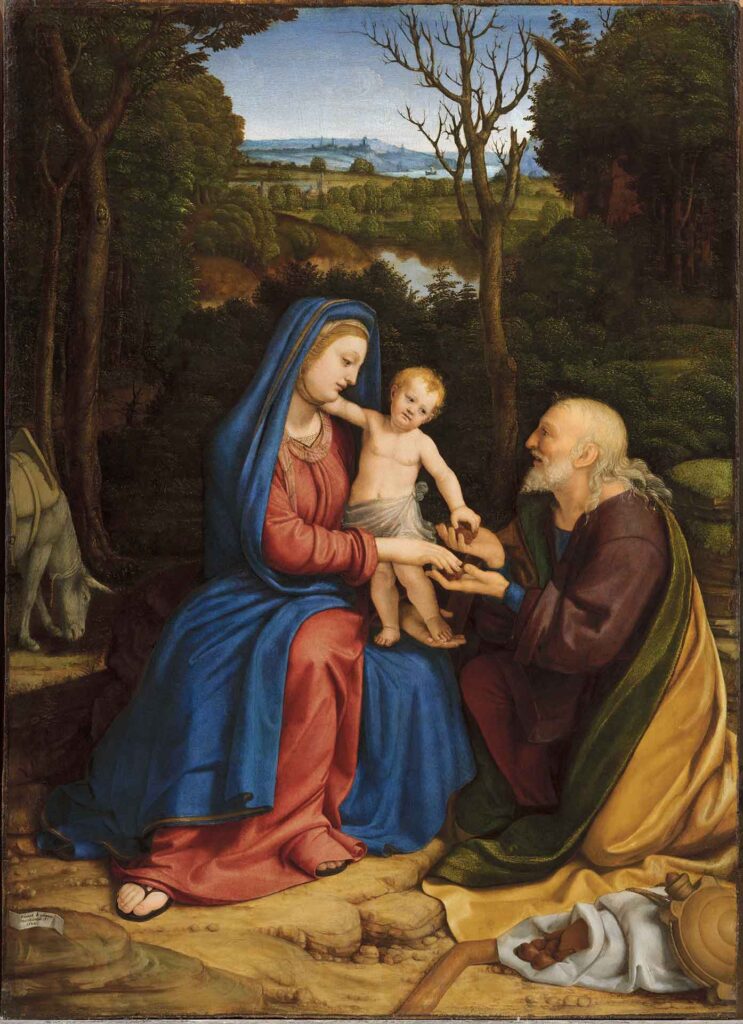Rest on the Flight into Egypt
Andrea Solario , 1515
Description

The Rest on the Flight into Egypt, signed and dated 1515, is one of the best known and appreciated works by Andrea Solario, one the most original followers of Leonardo in Lombardy. In his refined art, Leonardesque elements combine with other artistic cultures: the Lombard tradition, the Venetian painting (the artist spent some years in Venice), the ancient and contemporary sculpture.
In this painting all these references merge into one lyrical whole: the background landscape and the rich palette refer to the Venetian culture, while derive from Lombard art (with Flemish influences) the more naturalistic elements, such as the donkey browsing the grass and the splendid and carefully detailed still life with the pilgrim’s staff, bag, and flask.
Leonardo’s influence appears clearly in the Virgin’s profile and in the torsion of her bust, as well as in the exchange of gazes that unites the figures in an intimate dialogue. The group has a plastic quality, reminding of the year spent by Solario with his elder brother, the sculptor Cristoforo Solari, called Il Gobbo.
Bought in 1855, the painting is one of the first works chosen by Gian Giacomo Poldi Pezzoli. Afterwards, other paintings by Solario were acquired by him and by the Poldi Pezzoli Museum, that has today one of the most important collections of paintings by this artist.
Data Sheet
Author
Andrea Solario, documented 1481 -1524
Date
1515
Material and technique
Oil on panel
Measures
76.8 cm x 55 cm
Acquisition
Gian Giacomo Poldi Pezzoli bequest, 1879
Inventory number
1628
location
Lombard Rooms
The three rooms display Lombard paintings of the Renaissance, made during the years (1450-1535) when Milan and Lombardy were ruled by the Sforzas, who gave birth to one of the most splendid courts in Europe. They are mostly panels for private devotion, purchased by Gian Giacomo Poldi Pezzoli in the later 19th century.
Beginning in 1450, Vincenzo Foppa helped give a new identity to Lombard art, and this renewal was joined in the last quarter of the 15th century by the presence in Milan of the Urbino architect Donato Bramante and the Florentine Leonardo da Vinci
Thanks to Leonardo, an artistic school developed that drew from his teachings the skilful use of sfumato, the careful study of nature, and the rendering of movement and the motions of the figures’ souls.
The rooms feature works by both his pupils such as Giovanni Antonio Boltraffio, Marco d’Oggiono, and artists who compared themselves with him such as Bernardo Zenale, Giampietrino, Cesare da Sesto, Andrea Solario, and Bernardino Luini.
Since 1951 the tablets that decorated Palazzo Vimercati in Crema (c. 1500) have been displayed on the ceiling. They were a typical decoration on the ceilings of public and private buildings in Lombardy between the Gothic and Renaissance periods.
The new lighting was provided by the Associazione Amici del Museo Poldi Pezzoli.
collection
Paintings
The Museum hosts over 300 paintings. Among them, many Italian works from the Renaissance: masterpieces from Tuscany (Botticelli, Piero della Francesca, Pollaiuolo), Lombardy (Luini, Boltraffio, Solario) and Veneto (Bellini, Mantegna). Important is also the group of 18th century Italian painting (Guardi, Canaletto, Tiepolo, Fra Galgario). In the collection, there are mainly portraits and small size paintings.
